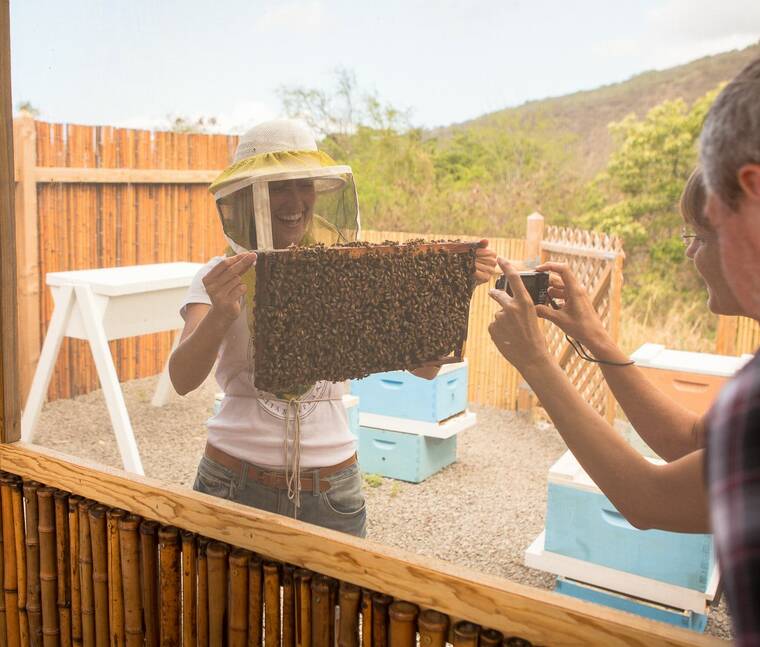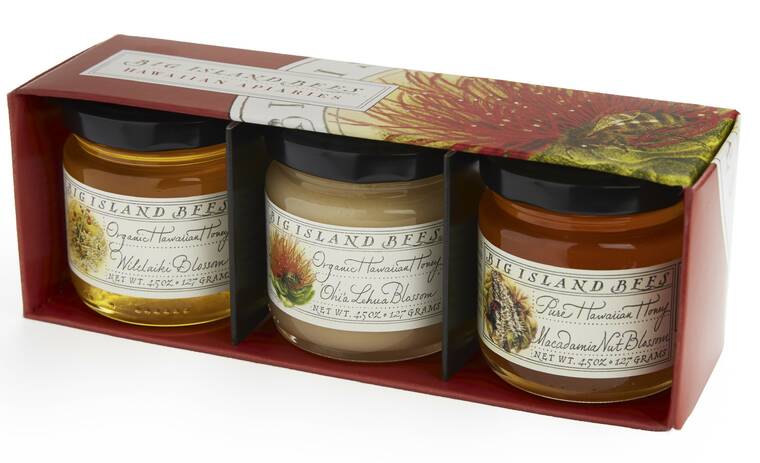When Whendi Grad met Garnett Puett in 1981 at the University of Washington art school, she didn’t know he was from a family of Hawaiian beekeepers. Whendi was studying textile design. Garnett was studying sculpture. They moved to New York City in 1983 and began pursuing careers as artists there.
Garnett continued to work on his family apiary in Hawaii during the summers. He and Whendi married in 1985 and in 1988, they decided to move to Hawaii full time. Garnett bought the family farm along with his old friend Ben Cariaga. He and Ben had years of experience keeping bees together since they were teenagers.
At that point, Captain Cook Honey Company was successfully producing honey in large volumes and shipping it to honey packers on the mainland. Whendi soon saw an opportunity to expand the family business and offer local packing and shipping of smaller quantities to local residents as well as visitors.
She and her brother Phil, decided to start Big Island Bees in 2004. Whendi began a wholesale business, selling honey to stores all over Hawaii as well as at farmer’s markets. She also opened a beekeeping museum and sales room in a building on Napo’opo’o Road that once served as the warehouse for the Kona Queen Company. The museum and shop are open Monday through Friday from 10 a.m. to 3 p.m.
According to Queen bee Whendi, “Offering an agrotourism destination was always a goal of mine.”
They began offering beekeeping tours in 2010, originating at their nearby honey farm at 82-1140 Meli Road. The hour-long tours include an open beehive exploration of one of their hives where you get to see where the queen resides and how honey is made while behind a protective screen. The tour also includes tea and macnut honey tart bites with a honey tasting at the end.
The honey farm tours are often led by entomologist Joe O’Brian and include lots of interesting information about the special life of bees as well as a video that shows their beekeeping operation from the flower to the jar. Tours are available Monday through Friday at 10 a.m. and 1 p.m. The kama’aina rates are $25 for adults, $15 for those under 18 and $10 for a child. Reservations are encouraged. More information, a video about the tour and reservation opportunities are available at the website bigislandbees.com.
The website also has information about their museum and shop. Expanding her agrotourism goal, Whendi designed the museum as an educational resource with lots of information about bees, beekeeping and honey production. Also included are beekeeping tools and memorabilia as well as some of Garnett’s sculpture.
Residents really love the opportunity to buy locally sourced honey directly from the producers. In their shop, kama’aina as well as visitors can taste and purchase the three very different honey varietals that Big Island Bees produce as well as their flavored honeys and products made with honey and beeswax.
Whendi pointed out, “It is the intense flavors of our local honeys that makes them so unique.”
The taste varies depending on the flower the bees visit to make the honey. Macadamia honey has a velvety texture and a rich honey flavor. Organic lehua honey has a delicate floral flavor and a creamy texture. The organic Wilelaiki honey is derived from Christmas berry flowers and has an amber color and spicy flavor.
The honey packaged by Big Island Bees comes from more than 1,200 hives that are housed all around the island. Each site has one hundred or more hives that are maintained and harvested by experts from Captain Cook Honey. With the knowledge and experience from several generations of beekeeping, they understand the important relationship between the bees’ well-being and the environment.
The hives are moved periodically to take advantage of the plants’ blooming cycles. Most are in remote areas in order to produce single blossom honey and avoid products that might threaten their organic certification. Although some hives are placed on local farms, the farmers must have space for 100 plus hives and meet the rigorous standards the honey company demands.
This family operation is unique among commercial honey sellers. The honey they sell comes only from their own hives, which are carefully maintained without artificial feeds or chemical miticides. Also, no high-speed equipment is used in harvesting or processing their honey. Instead, they use a slow and deliberate procedure to prepare their honey that does not involve heat or filtration. The result is pure Hawaiian produced honey that can be truthfully labeled ‘Made in Hawaii’.
Also unique in this beekeeping family is their love of bees’ majestic artistry. This is definitely visible in some of Garnett’s apisculptures done in beeswax. He describes his creative process as a collaboration with the bees. His work has been exhibited at the Hirshorn Museum in Washington DC and other locales around the world.
Beekeeping in Hawaii has become a labor-intensive activity requiring diligence and knowledge. The varroa mite arrived here in 2008 killing off most feral bees. It remains the most damaging pest to Hawaii’s honeybees. In addition, the small hive beetle and several diseases make regular hive inspections and treatments necessary.
As Queen Bee, Whendi oversees the store as well as packing and shipping operations. She works mostly onsite writing the newsletter and creating recipes that take advantage of the flavor profiles of their honey varietals. You can check out numerous recipes on their website as well as her recipe for a coffee-honey facial mask.
Thankfully, lots of knowledgeable folks work with Whendi at Big Island Bees. Her friend, Sharona Lomberg manages the store and helps out wherever she can. An all-woman crew runs the labeling and packing part of the operation headed by experienced beekeeper Lisa Oliverez. Laryssa Kwoczak used to help with the tours and offer honey tastings. She now is at home with her young children but still actively involved with bees. She offers graphics help to Big Island Bees and she teaches online beekeeping classes at www.beekeepingmadesimple.com.
To help with shipping and handling, Whendi hired Jody, who runs a third-party fulfillment house, to do their shipping. After a recent mention of the company in Martha Stewart’ s magazine, Jody nearly doubled her hours to get the orders filled correctly and on time. It takes a village.
If you want to learn more about bees and their interesting lives and their delicious products, Big Island Bees is the place to go. Don’t leave without tasting their made-in-Hawaii honey and taking home some to enjoy or give as a unique Hawaiian gift.
Gardening events
Saturdays: Work Day at Amy Greenwell Garden, from 9 a.m. to 12:30 p.m. Meet at the Garden Visitor Center across from the Manago Hotel in Captain Cook. Come with a mask and prepared to practice social distancing. Volunteers can help with garden maintenance and are invited to bring a brown bag lunch. Water and snacks provided. Visit the website www.amygreenwell.garden/get-involved/volunteer-1/ and sign up for the weekly email for more information on work days.
Tuesdays: Coffee related webinars with live Q&A with the presenters, (through April 30) starting at noon. Hosted at the Kona Extension YouTube account. Register at https://www.hawaiicoffeeed.com/coffeewebinars.html.
March 19: Black Twig Borer with Rob Curtiss of Washington State University and Bob Smith of Smith Farms; Coffee Pruning with Andrea Kawabata of UH-CTAHR.
March 6: Management Tools for Kona Coffee Root-knot Nematode with Roxana Myers of USDA ARS DKI PBARC.
March-April: “Live Webinars by Hawaii Small Business Development Center” – go to Events and Workshops at hisbdc.org for more information and to register for the following. Fee $15.
March 21: How to Hire, Train and Retain Stellar Employees.
March 28: Starting a Business in Hawaii
April 18: Personal Finances for Business Owners
April 24: Analyzing Financial Statements – focus on Balance Sheet
May 8: Analyzing Financial Statements – focus on Income Statement
Farmer direct markets
(Check websites for the latest hours and online markets)
Wednesday and Friday: Ho‘oulu Farmers Market, 9 a.m. to 2 p.m.- Sheraton Kona Resort at Keauhou Bay
Saturday: Keauhou Farmers Market, 8 a.m. to noon at Keauhou Shopping Center
Kamuela Farmer’s Market, 7:30 a.m. to noon at Pukalani Stables
Waimea Town Market, 7:30 a.m. to noon at the Parker School in central Waimea
Waimea Homestead Farmers Market, from 7:30 a.m. to noon at the Waimea middle and elementary school playground
Sunday: Pure Kona Green Market, 9 a.m. – 2 p.m. at Amy Greenwell Garden in Captain Cook
Hamakua Harvest, 9 a.m. to 2 p.m. at Hwy 19 and Mamane Street in Honokaa
Plant Advice Lines Anytime: konamg@hawaii.edu Tuesdays and Thursdays: 9 a.m. to noon at UH-CES in Kainaliu – 322-4893 or walk in Mon., Tues. and Fri: 9 a.m. to noon at UH CES at Komohana in Hilo. Call 981-5199 or email himga@hawaii.edu.
Diana Duff is a plant adviser, educator and consultant living part time in Kailua-Kona.


